John Janaro's Blog, page 51
July 13, 2023
“Summer Skies”
Here’s a work of digital art by JJStudios: a breath of cool air for your mind on these warm buggy July evenings.

July 12, 2023
Christina Grimmie and the YouTube Creative Revolution
 There are so many dimensions of Christina Grimmie’s life that I have grown to know and love over the past seven years, as anyone who reads these “almost-monthly” tributes knows. But sometimes I forget to express sufficiently my appreciation for the fundamental talent—the gift, the “genius”—that pervaded her life, that she developed with relentless dedication, that first drew the support of her frands from every corner of the earth, and that continues to amaze and astonish me afresh every time I see and hear it.
There are so many dimensions of Christina Grimmie’s life that I have grown to know and love over the past seven years, as anyone who reads these “almost-monthly” tributes knows. But sometimes I forget to express sufficiently my appreciation for the fundamental talent—the gift, the “genius”—that pervaded her life, that she developed with relentless dedication, that first drew the support of her frands from every corner of the earth, and that continues to amaze and astonish me afresh every time I see and hear it.The simple facts are: Christina was a brilliant and creative musician and songwriter, a groundbreaking, innovative, and charismatic performing artist, and—above all—a great singer. But she also had the singular distinction of putting all of this into a “package” and communicating it through a new form of media when that interactive audiovisual media platform was still young and malleable, when its possibilities were still being discovered and invented.
YouTube was (and remains) the largest and most flexible “space” for the ongoing revolution that is flipping the whole dynamic of the relationship between the viewer and the screen—a dynamic that had dominated audiovisual media for half a century, which for my generation (the “late boomers” who never knew a world without ubiquitous TV) spanned our whole lives. It was like people hardly noticed the change as it was taking place. They started “watching” YouTube, and soon discovered that they could comment on the videos by opening their own YouTube account, and this account empowered them to post their own videos if they wanted to. Even if the vast majority of people remained “viewers” and didn’t “broadcast” their own videos to what rapidly became a global public audience, they could not avoid realizing that a new horizon had been opened.
In the first decade of the 21st century YouTube turned every viewer into a potential broadcaster. After 50 years of “watching TV,” it took me some time to realize that, suddenly, I had been invested with my own personal television station with the potential to reach anyone in the world… for free! Like most people, I didn’t have the skill or the time to make much use of it. But the younger generation adapted spontaneously and began to produce innovative content. YouTube—almost “accidentally,” without anyone realizing what was happening—connected creative people to the whole world in a way that was unprecedentedly simple and inexpensive. It was so easy to share videos on YouTube that kids could do it. So, they did.
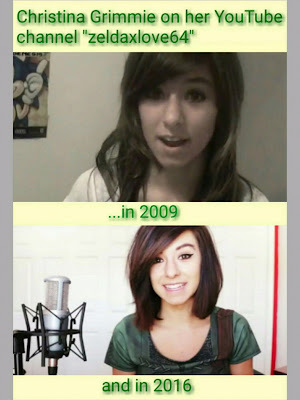 Mostly, they did it for fun. Some also daydreamed wildly of being “discovered” by a rich and famous entertainment-industry-“gatekeeper,” taken under his or her patronage, and launched into superstardom. It was still a crazy dream 15 years ago, but it did seem slightly less impossible than before.
Mostly, they did it for fun. Some also daydreamed wildly of being “discovered” by a rich and famous entertainment-industry-“gatekeeper,” taken under his or her patronage, and launched into superstardom. It was still a crazy dream 15 years ago, but it did seem slightly less impossible than before.The daydream of being discovered—in itself—was an old and inextinguishable daydream in the minds of generations of youth. My band mates and I “dreamed” in the ‘70s of being “discovered” and becoming famous. Both myself and my fellow guitarist could take turns shredding epic leads (actually, we were pretty good). But none of us could sing. If only we’d had a “Christina Grimmie” at our high school! But it wasn’t meant to be, and in any case none of us were sufficiently driven by our daydreams in this regard. We were happy enough having a nerd-fest pouring over the latest music equipment catalogues and “dreaming” of owning a stack of Marshall amps and all the latest sound-altering gadgets.
After my own youth had passed, I continued to pay attention to the music scene, and I noticed the increased possibilities of sharing music through recorded media: quality cassette recording made “demo tapes” possible, and video tapes widened the sphere wherein one could seek an audience. Tapes could be copied and distributed through the mail. A simple demo tape might catch the attention of a person with bigger “connections” who might get it to a music manager who might pass it around until, maybe, an A&R developer at one of the many record labels in the vastly enlarged music industry took an interest in it. This could lead to a recording contract and, with determination and a lot of luck, eventual superstardom… which was the only way to spread your music around the world and build a global base of committed fans who appreciated and supported it.
Worldwide popular music success was necessarily linked to celebrity status, with all the vainglory, pressures, expectations, anxieties, isolation, and self-alienating and destructive behavior this status frequently entailed. Music needed new outlets, new ways expression that enabled the artist to remain in control of his or her craft.
Although I took up the teaching and academic profession and it remains the primary focus of my professional activities, I have also been immersed for most of my life in many facets of music. I have been on both sides of the stage in concerts of diverse genres. I was classically trained on the cello, and taught myself electric and acoustic guitar. I learned to read musical notation and wrote instrumental music (and I’m trying to revive those efforts). I have also participated in the tremendous expansion of media and technology for musical performance and recording that has taken place during the span of my own lifetime. From “stereophonic” vinyl records to cassettes to CDs to iPods to Spotify and streaming audio, from “concert films” and documentaries to multi-camera-angle television broadcasts to MTV to concert DVDs of outstanding quality, from basic musical instruments (which in themselves are the fruit of centuries of craft and technical refinement) to analogue electronic augmentation (I had a “transducer” in the 1970s to amplify my cello) and the complex, huge, and amazing versatility of the analogue Synthesizer (1960s-70s) to the increasing sophistication and digital transformation of the portable electronic keyboard… I could go on and on…
 In any case, I knew that the outlets for musical creativity (and other forms of creativity) were bound to expand in the wild explosion of interconnectedness that the internet was spreading like fire in the global village. We were already seeing this phenomenon (with regard to the written word) in social media as the years passed in first decade of the 21st century. Blogs were everywhere. I began blogging in 2006, although my early ventures didn’t last. This present blog, however, has endured.
In any case, I knew that the outlets for musical creativity (and other forms of creativity) were bound to expand in the wild explosion of interconnectedness that the internet was spreading like fire in the global village. We were already seeing this phenomenon (with regard to the written word) in social media as the years passed in first decade of the 21st century. Blogs were everywhere. I began blogging in 2006, although my early ventures didn’t last. This present blog, however, has endured. But I was blindsided by YouTube. When it first appeared, it seemed like just another way to watch videos. By the time my adolescent kids started showing me what was happening with YouTube creators, it had already been going on for some time and already had established artists. Only in retrospect did I see how it all began and how it grew.
Mainstream highly-produced music videos by pop stars grabbed most of the attention of music audiences and got the most “views” in the beginning—for that matter, they still do today. But people began to post their own videos, playing music and singing from their own bedrooms (and, sometimes, bathrooms—because of the superior acoustics there). This often began with the sense that only a small circle of friends would be watching them sing cover songs karaoke-style. But from the beginning, remarkably talented people stood out and drew larger audiences. At first, YouTubers were as surprised as everyone else to see their videos “take off,” to get encouragement and comments from people from distant places, and to accumulate more views than they ever imagined possible.
Among these creative pioneers was a 15-year-old girl from Marleton, New Jersey, named Christina Grimmie. In the Summer of 2009 she began recording cover songs in her room with a laptop and a webcam. What was rare about Christina from the start, however, was not only her singing quality but also the way she interpreted each song, arranging her own “stripped down” versions for piano and then accompanying herself live on her electronic keyboard. Even with relatively primitive recording equipment, Christina put enormous work into crafting performances that were perfect (or nearly perfect) from start to finish. Her agile, beautiful voice and her unique arrangements captivated people in those first days. I try to imagine how astonishing it must have been to go through a bunch of different videos and suddenly stumble upon this girl expertly playing her piano and singing like an angel songs that you had heard “on the radio” (or wherever) before but that you had never heard in the form Christina Grimmie had given them. She brought her own sense of beauty to the songs she played and sang in that room, in front of a poster of Sonic the Hedgehog.
 She was a regular kid—with no promotion, no overhead, no tricks—creating beautiful new renditions of popular songs and broadcasting her videos directly on to your screen. I can only imagine what it must have been like to see her in those days, when the videos that (thankfully) we can still watch in her archives were posted fresh—for the first time—entirely unique in comparison to any of the other content surrounding them. It must have been a cause for wonder. It certainly inspired other young artists who came after her to take the risk of sharing their best music, to take the new media platform seriously, to “aim high” in their artistry.
She was a regular kid—with no promotion, no overhead, no tricks—creating beautiful new renditions of popular songs and broadcasting her videos directly on to your screen. I can only imagine what it must have been like to see her in those days, when the videos that (thankfully) we can still watch in her archives were posted fresh—for the first time—entirely unique in comparison to any of the other content surrounding them. It must have been a cause for wonder. It certainly inspired other young artists who came after her to take the risk of sharing their best music, to take the new media platform seriously, to “aim high” in their artistry.Of course, it wasn’t long before Christina was noticed by people who could help her advance her music career in more conventional ways. She gained everyone’s attention in those few unforgettable weeks in 2014, on Season Six of The Voice (broadcast in the USA on “old-fashioned” network TV). Her singing became more expansive and more passionate as she gained experience and her voice began to mature, and as she expanded the repertoire of her own original songs. During those final two years, her music became more inspiring, comforting, thrilling, evocative, luminous, and soul-shaking. Still she stayed with her YouTube channel and continued her series of inimitable cover songs. She had frands all over the world, and met some of them face-to-face in tours and performances in Europe, Singapore, the Philippines, and the USA. Her voice and her talent were at the level of once-in-a-generation by the time she was 22 years old. I tremble when I imagine how great she might have become. For anyone who is an artist, or a human being, the awful tragedy of Christina Grimmie’s death seven years and one month ago is an enduring sorrow.
Still, she left a creative legacy that remains foundational for music and media in our time, and—undoubtedly—for the times to come.
July 11, 2023
The Story of “Young Saint Benedict”
 On this beautiful July 11th—the feast of Saint Benedict—I knew I had more to offer than experiments with digital graphics or colorful renditions of the “proper prayers” for the liturgical celebration. I decided to reproduce the my column in Magnificat from March 2015 (more that eight years ago) on the “conversion” of Saint Benedict. As you will see, this is a different kind of “conversion,” as Benedict was raised a Catholic Christian and remained faithful to his baptism. This is the story of Benedict’s deeper conversion—we might call it his “vocation story” (and every vocation prompts a more profound, interior conversion).
On this beautiful July 11th—the feast of Saint Benedict—I knew I had more to offer than experiments with digital graphics or colorful renditions of the “proper prayers” for the liturgical celebration. I decided to reproduce the my column in Magnificat from March 2015 (more that eight years ago) on the “conversion” of Saint Benedict. As you will see, this is a different kind of “conversion,” as Benedict was raised a Catholic Christian and remained faithful to his baptism. This is the story of Benedict’s deeper conversion—we might call it his “vocation story” (and every vocation prompts a more profound, interior conversion).Saint Benedict’s “flight to the desert” was a radical response to a grace which he hardly understood at the beginning, but which began to be realized by his fidelity to the prompting of the Holy Spirit and the guidance from brothers in Christ to whom he was entrusted along the way.
The column is below. As you see, also, I did not neglect the JJStudios virtual workshop. I have rendered (above) a visual “interpretation” of Saint Benedict in his later years, when he was Abbot of the Monte Cassino. I also have placed today’s (very rich) proper prayers in colorful settings. Perhaps these efforts remotely approach something like “beauty” in the widest and most expansive analogical sense of the term.😉
Nevertheless, let me share the fruits of my own primary and professional labors, in the medium of words from my monthly column (which tells a new story every month from December 2013 to the present):
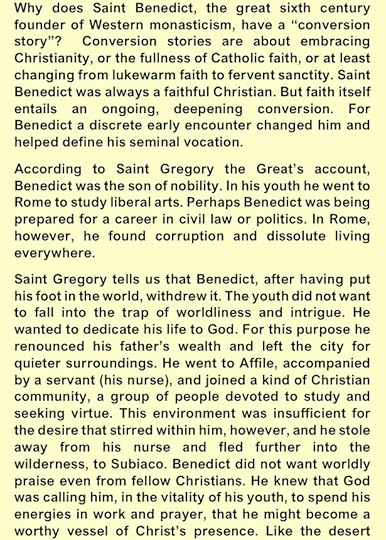
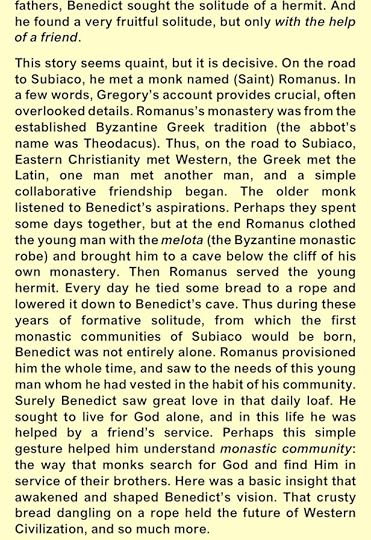 Indeed!
Indeed!And here are the prayers for today:

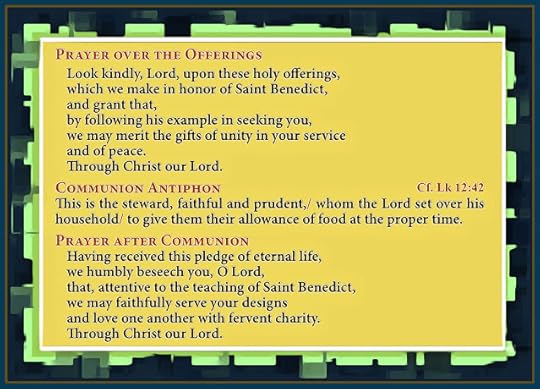
July 6, 2023
Escalation in the Ukraine War: Can We Find “Paths of Peace”?
 Some sectors of opinion have expressed frustration at Pope Francis because he doesn’t seem to be more “Pro-Ukraine” in the ongoing war. However, not only would such temporal partisanship serve no practical purpose. It would also hinder the Pope from carrying out his essential role for Christian peoples and for the whole world.
Some sectors of opinion have expressed frustration at Pope Francis because he doesn’t seem to be more “Pro-Ukraine” in the ongoing war. However, not only would such temporal partisanship serve no practical purpose. It would also hinder the Pope from carrying out his essential role for Christian peoples and for the whole world.Francis has recognized that the Ukrainian people have a right to defend themselves. He has expressed his awareness of and solidarity with them in the immense suffering that has been inflicted upon them. He is not speaking here (see below) as a diplomat trying to broker some sort of inadequate compromise that ignores the requirements of “a just and stable peace.” As a Pastor, he must encourage peace because he knows that God will give the gift of peace to those who convert to Him and seek ways to love one another. The inherently reckless trajectory and desperation of intractable wars—especially modern technologically destructive wars—wreak havoc on a huge scale, radically destabilize the international order, tend to spiral out of control more and more, and sow the seeds of vengeance and resentment between peoples that lead to further wars. The Pope is therefore emphasizing that every morally possible means that might contribute to building peace must be given attention and consideration, in order to move toward bringing about a just and equitable conclusion to this conflict with its increasingly wanton and large-scale destruction. The explosion of the Nova Kakhovka dam, for example, has not only put homes and lands throughout the region underwater—see top picture—but it is also an environmental catastrophe much larger than many of us in the West appreciate. The time and cost (even the possibility!) of recovering the land for habitation and restoring its prior terrestrial vitality is incalculable. The fact that this was almost certainly the fault of Putin’s Russian forces cannot be forgotten (nor can anyone afford to ignore the danger that the massive Russian-controlled Zaporizhzhia nuclear power plant might be deliberately damaged—sending toxic radiation on west winds over Ukraine, Poland, Germany, and other parts of Europe in a disaster that would make 1986 Chernobyl look small by comparison). .
International law points to the duty to impose punishments, insofar as it is possible, on the perpetrators of these war crimes according to justice in the service of peace (not, however, as a tool for revenge by the victors). But wars often brings their own “rough justice” (or vengeance) against those who commit crimes within them. At present, it seems that Putin no longer has stable control over his own armies, especially the large “contract forces” of the Wagner group. Their recent march toward Moscow was not “defeated” but rather “called off” by Wagner’s own leader. Wagner troops remain in their camps. If Putin is ultimately overthrown, he is likely to be replaced by someone more reckless and dangerous.
Meanwhile, wars are fought between human persons. Even the Russian leaders are persons. The Ukrainians are (and will be) challenged immensely by the need to look upon their enemies as persons—with the dignity they ineradicably possess as persons—even as the Ukrainians use military force in their efforts to liberate their country and rescue their own people. Only the grace of Christ can empower them to face this challenge and sustain this “inner non-violence” that is the radical foundation of true peace. And then there are Ukraine’s Western (undeclared) “allies,” some of whom want to avoid risking their own super-comfortable materialist-saturated lifestyles and choose instead to give Ukrainians weapons and money according to their own agendas; there are undoubtedly many agendas at work here—not in a conspiratorial way, but haphazardly—fraught with inner tensions and known only to those who are driven by them. Such is the dynamic of chaos, power, internal divisions, and alienation that results from “the idolatry of money.” As for our respecting the dignity of persons in this conflict and everywhere else in the world, we in the West need to resolve our own unprecedented level of confusion about human realities, our reductionist identity politics, our callow disregard for vulnerable and powerless people from whom we have nothing to gain for ourselves, and our bewildering hyper-excessive, thoughtless, heartless lifestyles, so that we can renew and cultivate our understanding of what it means to be a human person.
Human persons are suffering because of this war. Channels of dialogue between human persons must be sought out and opened up, however small they may be. So many circumstances in war are uncontrollable, and even those who strive to use force with justice and restraint to defend themselves need also to talk to persons who represent the other side. They must remember the humanity of the actual persons they fight—often helpless young conscripts—who are being used (even coerced) to do the dirty work of brutal and incompetent leaders. This is a heroic posture to maintain; it is a spirit of “inner non-violence” that must be held firmly even (especially!) when it becomes necessary to use external force. Modern warfare so easily loses the sense of restraint and honesty in the use of “proportionate means,” and pushes forward technological weapons that are designed to prioritize “efficiency” over respect for the human dignity of the adversary. That dignity must not be violated, even when the enemy doesn’t seem to deserve such respect. It remains a matter of honor for those who truly wish to serve their homeland by defending and rescuing their compatriots. When there is failure here, it should be followed by sorrow, humility, repentance, and a renewed dedication to the difficult task of loving one’s enemies even in the fight—to keep one’s honor and to be ready always to seek ways toward peace.
The channels of dialogue must therefore remain open to the humanity of the others, with readiness to allow space for change, for repentance, for new perspectives, for a willingness to engage in honest conversation. They also must be ready for the possibility that suddenly “the other side” might be led by different persons with different aims. Their aims may remain violent, but their rationales, their grudges, their grievances, their personal and social wounds may be very different. Firm, frank, open-hearted dialogue is the only way to learn who these person are, on “the other side,” how they may be changing, and what new possibilities may open up.
The point of dialogue is above all not negotiating compromise but building (however slowly and painfully) mutual understanding. It is a small, seemingly powerless “instrument” through which people can actively “love their enemies” and sow seeds for interpersonal relationships. This is not achieved by naïveté but by hard work that only God can make possible. Societies and cultures, as well as particular people, must not “return evil for evil,” but trust in God and work relentlessly to “overcome evil with good” (see Romans 12:17-21). Seeking true dialogue engages people in the works of mercy, and mercy is what is needed to bring fully human healing to war-torn places.
We all need to remember these things, even if there aren’t any easy answers for how to bring about a just peace. Vladimir Putin and his government unleashed this war, but all of us must seek peace, pray for peace, be converted for peace, make sacrifices for peace, and look beyond our own selfish interests for the sake of a peace that has any chance of being real.
Pope Francis says these words quoted below because they are true. And he is speaking not only to Russia, nor only to Russia and Ukraine, but to all of us in a world where we can no longer afford not to work together, where we must recognize one another as neighbors—brothers and sisters—even if we’d rather not. The possible dangers are too great for us to just wave banners and look upon this conflict like it’s a game (and be proud of ourselves for backing the “winner”).
Here are the Pope’s recent words:
“All wars are in fact disasters, utter disasters: for peoples and families, for children and the elderly, for people forced to leave their country, for cities and villages, and for creation, as we have recently seen following the destruction of the Nova Kakhovka dam… The tragic reality of this apparently interminable war requires a common creative effort on the part of all to envision and create paths of peace, in view of a just and stable peace.
“What stands in the way of peace is ultimately the bitter root that we carry within us: greed, the selfish desire to pursue our own interests at the personal, community, national and even religious levels.
“The remedy is the conversion of hearts, renewing them with the love of the Father,” the Pope emphasized. The achievement of true peace requires “a gracious and universal love that is not confined to our own group.”
July 5, 2023
“How Many Fireflies?”
Can you guess? Look closely!🙂
“How Many Fireflies”
Can you guess? Look closely!🙂
July 3, 2023
After Two Years, I Still Miss My Mom
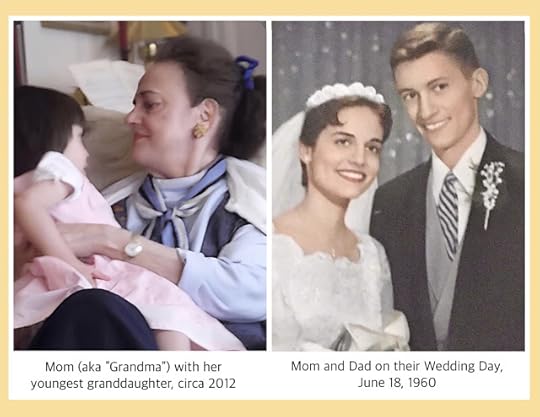 Today marks the second anniversary of my mother’s death. We pray for her, entrusting her to the goodness and mercy of God. May the Lord Jesus give her eternal life.
Today marks the second anniversary of my mother’s death. We pray for her, entrusting her to the goodness and mercy of God. May the Lord Jesus give her eternal life.I know that “in death, life is not ended, but changed.” My parents are nearer to me than I realize, yet with my eyes of this world I can’t see them, and my ears can’t hear them. I miss them in these days of the mysterious journey of my life.
Time is so fragile. I can’t see the new steps that lie before me. Sometimes I wish I could talk to my parents, to ask them how to grow old, how to let go, how to become simple. I move forward with a sense of obscurity, but also with hope. May the One who is Infinite Love embrace us all in his mercy.
July 1, 2023
Saint Junipero Serra: Faithful to His Mission
 July 1st is the feast day celebration of Saint Junipero Serra, who remains the patron saint of California and one of the crucial saints for all the people of the United States of America, even (perhaps especially) for those who have slandered and attacked him in recent years.
July 1st is the feast day celebration of Saint Junipero Serra, who remains the patron saint of California and one of the crucial saints for all the people of the United States of America, even (perhaps especially) for those who have slandered and attacked him in recent years.Father Serra is a saint; we know this from the Holy Spirit’s guarantee that insures the veracity of a formal canonization by the Church. Certainly, Father Serra was a man shaped by his times and constrained by the limitations of the evangelizing methods available to him in 18th century Spanish America. But this only makes his heroic dedication to the spiritual and temporal welfare of the indigenous peoples more remarkable.
In spite of a painful physical disability that made him virtually lame, Serra traveled thousands of miles on foot up and down the coast and the mountains from San Diego to the Bay Area during the last 14 years of his life (1770-1784), establishing mission communities, serving his people, and defending them tirelessly against the powers of the military forces and the colonists who would have otherwise pushed the natives to the ground without a thought.
Becoming a saint does not mean never making mistakes, or always enacting miraculously visionary judgments and having perfect solutions to every complicated problem. Father Serra knew he was a sinner, but he had a passion for the glory of Christ and he allowed the grace of the Holy Spirit to transform him by leading him from the comforts of his home and his university professorship in Mallorca to serve Christ in His poor brothers and sisters on the other side of the world. He became a saint by persevering in following Christ and fulfilling his vocation, with a humility that the millions who have come to California in the past two centuries and live from the wealth of its land would do well to admire.
We made many journeys to the California Missions in our younger days, when we visited Eileen’s parents in California. But it’s been eleven years since the last time our whole family was there. I miss California! The tall redwoods and the dry sea air always seemed to rejuvenate me.
Saint Junipero Serra no doubt continues to have a special solicitude for the people who live in California today: such multitudes of people—the few remaining descendants of the indigenous inhabitants (many of whom continue to foster their own historical identity in relation to the Missions that were homes to their forebears) as well as Anglos, Hispanics, African-Americans, Asian-Americans, and others whose ancestors came (or have come themselves) from all over the world—and with every one of them in need of the Gospel and the experience of a new encounter with the love of God in Jesus Christ.
June 30, 2023
“Images of June 2023”
June 28, 2023
Saint Irenaeus: The Harmonious Melody of Creation
 Today is the feast of the great Saint Irenaeus, Bishop and Doctor of the Church from the late second century. His response to the gnostic heresies of the time resulted in more than a polemic. It articulated a profound early theology of the Trinity, the creation of the world by God, and the reality of the incarnation, death, and resurrection of Jesus Christ, the Word made flesh.
Today is the feast of the great Saint Irenaeus, Bishop and Doctor of the Church from the late second century. His response to the gnostic heresies of the time resulted in more than a polemic. It articulated a profound early theology of the Trinity, the creation of the world by God, and the reality of the incarnation, death, and resurrection of Jesus Christ, the Word made flesh.Here is a text of Saint Irenaeus that I would like to share for today’s feast:
“Created things, in their great number and diversity, fit beautifully and harmoniously into the creation as a whole. And yet, when viewed individually, they appear discordant and opposed to each other, just as the sound of the lute makes a single harmonious melody out of many and opposite notes by means of the intervals between them. The lover of truth must not be deceived, therefore, by the interval between the different notes, nor imagine that this note was the work of one artist and author, and that note due to another… He must not forget that one and the same Artist was responsible for the wisdom, justice, goodness, and munificence of the whole work. And those who listen to the melody ought to praise and glorify the Artist, and admire the tension of some notes, appreciate the relaxation in others, enjoy the moderation of those between the two extremes… Recalling that some things are symbols, they will consider what it is that each thing points to and what causes it. But they will never alter the rule, nor stray from the Artist, nor abandon faith in the one God who made all things, nor blaspheme our Creator. When someone fails to find the cause of all that he is investigating, he should recall that man is infinitely inferior to God. Man, you are not uncreated, and you have not existed from eternity with God, as His own Word has done. No, by His overflowing goodness you received the beginning of your existence, and have gradually learned from the Word the dispositions of the God who made you.”~Saint Irenaeus, Against the Heresies II:25 (2-4)








